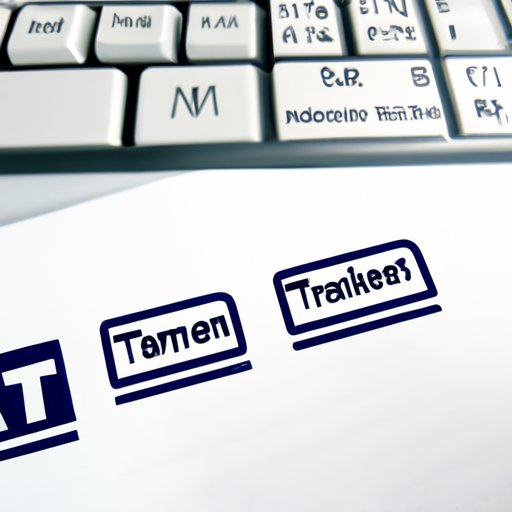
I. Introduction
Trademarks are an essential aspect of any business. They represent your brand, products, and services, and can make all the difference in your revenue growth. In today’s competitive market, it’s crucial to protect your business from infringement and copying. One of the most effective ways to do this is by trademarking your business name. This article provides a comprehensive guide on how to trademark your business name, from conducting a search to understanding the costs and benefits of registration.
II. A Step-by-Step Guide to Trademarking Your Business Name
Trademarking your business name is a relatively straightforward process. The primary steps include selecting a name that is not already taken, creating a unique logo, and filing for registration with the USPTO. Here’s a detailed step-by-step guide:
1. Choose a Unique Business Name
The first step to trademarking your business name is selecting a unique name. A unique name reduces the likelihood of trademark infringement. You can use different variations of your business name, but it’s crucial to ensure that it’s not similar to an existing trademark. You can browse the USPTO database to check for registered trademarks or hire a trademark attorney to assist with the search process. Once you select a unique business name, you can move on to the next step.
2. Create a Unique Logo
A logo is an essential aspect of your business and represents your brand. Once you have selected a business name, you’ll need to create a unique logo that represents your business. A unique logo reduces the likelihood of infringement and is a legally recognized trademark symbol. You can hire a professional designer or create one using online resources. It’s crucial to ensure that your logo represents your brand and is distinct from other logos.
3. File for Registration
The final step to trademarking your business name is filing for registration with the USPTO. Once you have a unique business name and logo, you can submit an application to the USPTO. The application should include your business name, logo, and details about your business. It’s essential to provide all the necessary information to ensure that your application is approved.
III. 5 Things to Know Before You Trademark Your Business Name
Before you trademark your business name, it’s crucial to know key considerations that can impact the registration process. Here are the five key considerations:
1. Business Purpose
Your business purpose determines the category of your trademark. It’s essential to understand your business category before filing for registration. The USPTO recognizes different categories of trademarks, including goods and services, collective, and certification marks.
2. Trademark Search
A trademark search is crucial before filing for registration. You can conduct a search using the USPTO database or hire a trademark attorney to assist with the search process. A comprehensive search ensures that your chosen business name and logo are unique and not similar to an existing trademark.
3. Use of the Trademark
It’s crucial to verify that your chosen business name and logo are eligible for registration. The USPTO requires a specific level of use to qualify for registration. It’s essential to ensure that your trademark is in use before filing for registration.
4. Trademark Infringement
Trademark infringement occurs when a business uses a trademark similar to an existing trademark. It’s important to verify that your chosen business name and logo do not infringe on an existing trademark. A comprehensive search reduces the likelihood of infringement.
5. International Registration
If you plan to expand your business internationally, it’s essential to know the trademark laws in the countries you wish to operate. International registration requires specific processes and requirements, which may differ from the US registration process.
IV. How to Conduct a Trademark Search for Your Business Name
A comprehensive trademark search is crucial before registering your business name. The search reduces the likelihood of infringing on an existing trademark and the subsequent legal repercussions. Here are the steps to conduct a comprehensive search:
1. Use USPTO’s Database
The USPTO provides a comprehensive database of registered and pending trademarks. You can use the search tool on the USPTO website to check for similar trademarks. The tool allows for various search parameters, including the trademark name, category, and owner.
2. Hire a Trademark Attorney
A trademark attorney can conduct a comprehensive search on your behalf and verify that your chosen business name and logo are unique. An attorney can also advise you on the best course of action if any infringement issues arise.
3. Use Other Third-party Resources
Several third-party resources can assist with trademark searches, including legal service providers and search engines.
V. Trademarking Your Business Name: Common Mistakes to Avoid
Trademark registration can be a complicated process. Several common mistakes can impact your registration, resulting in delays or even denial. The following are common mistakes you should avoid:
1. Choosing a Trademark Similar to Existing Trademarks
Choosing a trademark similar to an existing trademark increases the likelihood of trademark infringement. A comprehensive search ensures that your chosen business name and logo are unique.
2. Inadequate Use of the Trademark
The USPTO requires a specific level of use to qualify for registration. Providing inadequate use details can result in rejection of your application. It’s crucial to ensure that your trademark is in use and that you provide adequate proof of use during registration.
3. Incorrect Classification
The USPTO recognizes different categories of trademarks, including goods and services, certification, and collective marks. Incorrect classification can result in rejection of your application or infringement.
4. Descriptive Trademarks
Descriptive trademarks provide descriptions of the products or services, increasing the likelihood of infringement. It’s crucial to create unique trademarks that represent your brand accurately.

VI. From A to Z: A Glossary of Trademark Terms
Trademark registration involves several legal terms that can be confusing. Here’s a comprehensive glossary:
1. Trademark
A trademark is a unique symbol, logo, or phrase that represents a business or brand.
2. Infringement
Trademark infringement occurs when a business uses a trademark similar to an existing trademark.
3. Classification
Classification refers to the categorization of trademarks by the USPTO. The categories include goods and services, certification, and collective marks.
4. Owner
The owner is the entity that owns the trademark and has exclusive use rights.
5. Registration
Trademark registration is the process of filing an application with the USPTO and obtaining exclusive use rights for the trademark.
VII. Understanding the Cost of Trademarking Your Business Name
Trademark registration involves several costs, including application fees, attorney fees, and maintenance fees. Here’s a breakdown of the costs:
1. Application Fee
The USPTO charges a fee for filing a trademark application. The fee varies depending on the type of application you file.
2. Attorney Fees
Attorney fees depend on the complexity of your application and the level of legal assistance required. Hiring an attorney can ensure that your application is approved and reduce the likelihood of infringement.
3. Maintenance Fee
The USPTO charges a maintenance fee for registered trademarks to keep them in force. Failure to pay the fees can result in abandonment of your trademark.
4. International Fees
International fees may apply if you plan to expand your business internationally. The fees vary depending on the countries you wish to operate.
5. Miscellaneous Costs
Miscellaneous costs may include business name registration fees, logo design fees, and legal service fees.
VIII. The Benefits of a Trademarked Business Name
Trademarking your business name is an effective way to protect your brand and grow your revenue. Here are some benefits of trademarking your business name:
1. Exclusive Use Rights
Trademark registration provides exclusive use rights for the trademark owner, reducing the likelihood of infringement.
2. Competitive Edge
A trademarked business name and logo provide a competitive edge in the market, helping to differentiate your business from competitors.
3. Increased Revenue Growth
A trademarked business name and logo increase revenue growth by building brand recognition and customer loyalty.
4. Legal Protection
Trademark registration provides legal protection for your business, reducing the likelihood of infringement and legal repercussions.
IX. Conclusion
Trademarking your business name is crucial for building brand recognition, protecting your brand, and increasing your revenue growth. Conducting a comprehensive trademark search, avoiding common mistakes, and understanding the cost and benefits of registration are essential aspects of the registration process. We encourage business owners to trademark their business names and logos to ensure legal protection and business growth.
Additional resources for business owners to consult include the USPTO website, legal service providers, and trademark attorneys.




